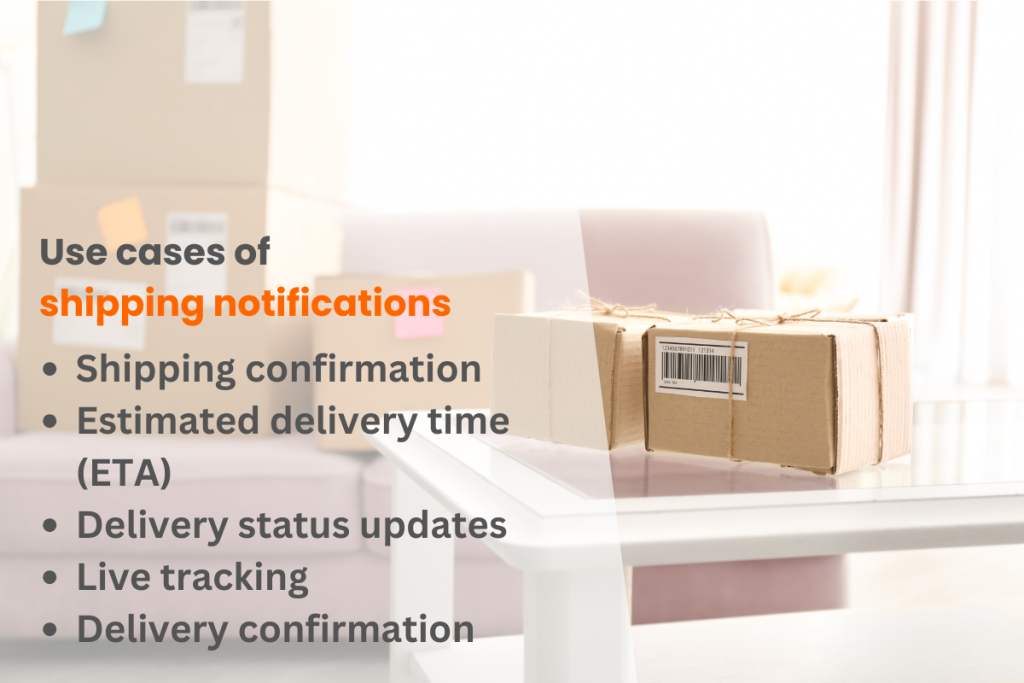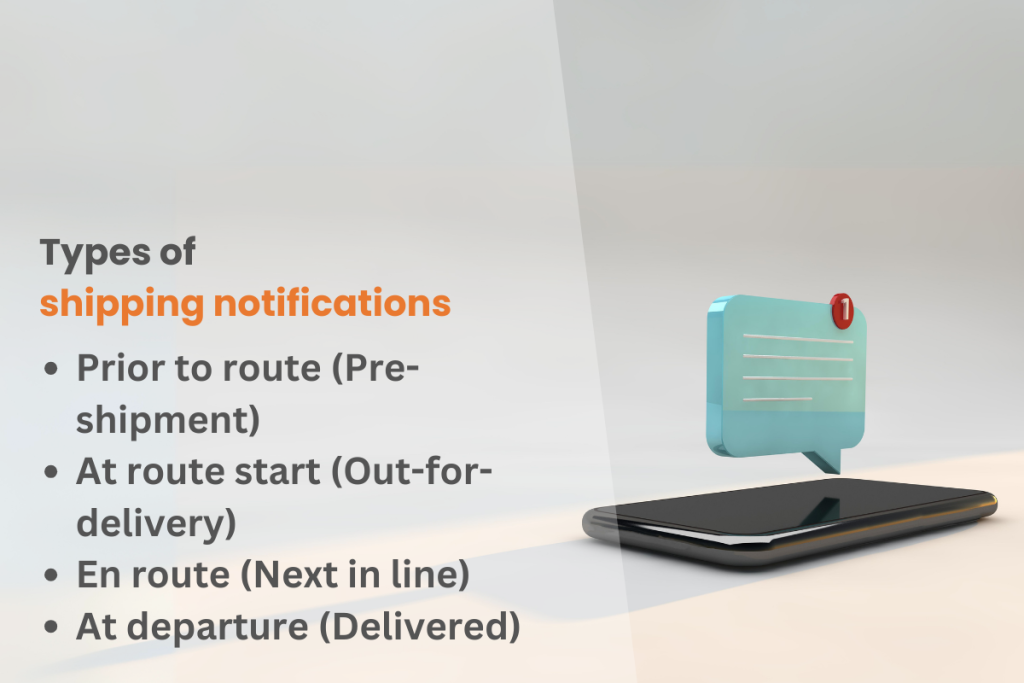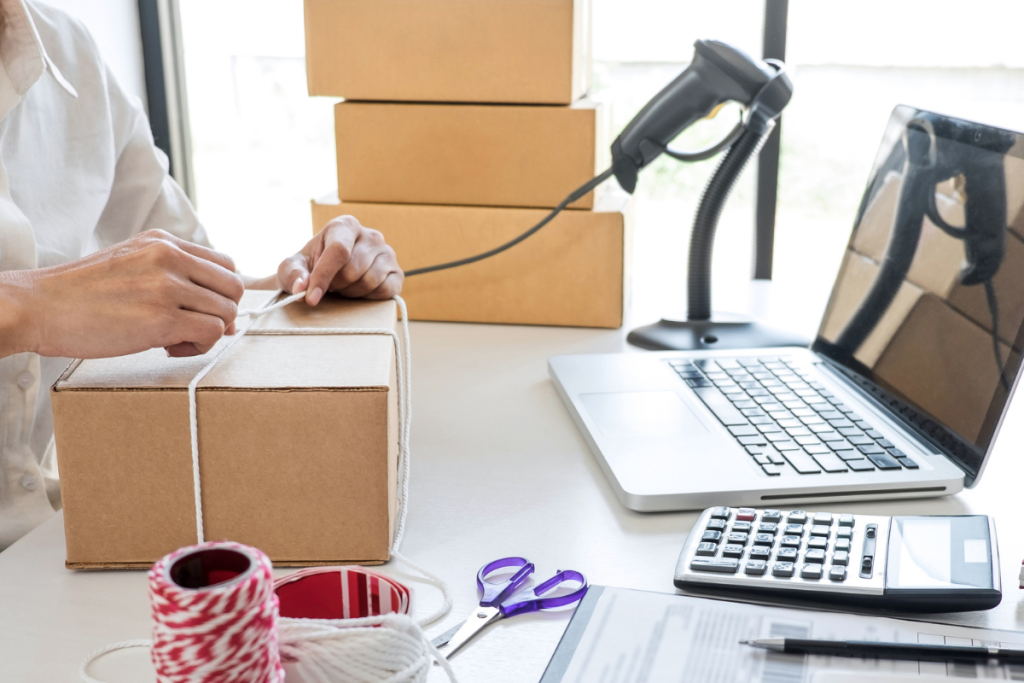Customer loyalty is the golden ticket that each company strives for.
Customers nowadays are seeking more than just high-quality goods and services. They also want a streamlined, stress-free delivery experience.
Shipping alerts have become a game-changer for companies wanting to create long-lasting customer ties.
Whether you’re an ecommerce giant or a small business owner, keeping your consumers posted on the status of their packages is crucial.
In this article, we’ll explore the key use cases and benefits of shipment notifications and provide you with actionable insights to optimize your shipping notifications process.
What are shipping notifications
Shipping notifications are automated alerts companies send to customers to provide updates on the status of their shipped orders.
These notifications typically include a live tracking link, an estimated delivery time (ETA), courier information, and a proof of delivery document.
Shipping notifications can be sent through various channels, including email, SMS, or mobile apps, and are a common practice in ecommerce and logistics industries.
To customize and send their shipment updates, businesses use various order management systems, logistics software, and advanced tools for custom shipping notifications.
Use cases of shipping notifications
Shipping notifications are a valuable tool for keeping customers informed throughout the delivery process.
Let’s define some of the most important use cases of shipping notifications for businesses.
Order confirmation
A shipping confirmation notification is sent once the order is received and ready to be routed and dispatched.
This message informs customers that their package is being processed for delivery. This type of notification usually contains an estimated delivery date and a time window if specified by the customer.
Estimated delivery time (ETA)
Along with the shipping confirmation, customer notifications provide an estimated delivery time.
ETA is calculated based on the shipping method, route complexity, and the selected delivery time slot.
ETA information helps customers anticipate when their package will arrive, making it easier for them to receive it.
Delivery status updates
Customers expect to receive timely updates as the package moves through various stages of the shipping process (e.g., out for delivery, en route, etc.).
This keeps customers informed about the real-time progress of their orders and any changes to the plan, e.g. force majeure.
Live tracking
A live tracking link, often attached to the shipment notifications, allows a customer to follow their package’s journey in real-time.
It helps to track the location of a courier and get ready to accept the shipment.
Delivery confirmation
Once the package is successfully delivered, businesses usually send a delivery confirmation notification.
Most companies attach an electronic proof of delivery (ePOD) document as a final shipping receipt. This document provides delivery proof (photo, e-signature, geotag, etc.) that customers can use in case of any queries.
This provides peace of mind to the customer and serves as a record of delivery in case any issues arise.
Types of shipping notifications
Different shipping notifications are usually closely linked to the order’s progress and delivery status.
Let’s review the most common types of shipment alerts that customers get at different stages of last-mile delivery.
Prior to route (Pre-shipment)
Notifications sent prior to delivery indicate that the order has been processed and is being prepared for shipping.
It can include order details and an estimated arrival date and time so customers can clearly understand when the package is expected to arrive.
At route start (Out-for-delivery)
Out-for-delivery notification is sent when the package leaves a warehouse or a shipping courier picks it up at the start of their route.
This type of notification typically includes a live tracking link and an ETA so customers can track their orders in real-time.
En route (Next in line)
En route notifications serve as a heads-up for customers next in line for delivery. It means that a courier is on the way to a recipient, and a package is just a step away from being in the customer’s hands.
En route shipment alerts usually include a live tracking link and an ETA, so the customer can get ready to collect their order.
At departure (Delivered)
At departure notifications are often accompanied by an order invoice and proof of delivery documents, and they act as delivery confirmation receipts.
They can also include a “rate us” link for client feedback on their delivery experience.
Shipping notifications and customer loyalty
Shipment notifications are a huge part of the overall ecommerce customer experience and satisfaction.
Now that we’ve covered the types and use cases of shipment notifications, we can look at how they affect customer loyalty.
1. Timely updates
Notifying customers of their packages’ whereabouts is crucial to the success of any logistics operations.
Shipping notifications let your customers know where their order is in real time.
They provide customers with a sense of security, knowing that you’re committed to keeping them in the loop throughout the delivery process.
This transparency reassures them that you’re on top of their order, making them feel valued and cared for, and statistics confirms that.
Open rates for shipping notification emails are 4 to 8 times higher than traditional emails because customers usually ask for the information contained in them, according to Campaign Monitor research. Moreover, 90% customers prefer to be engaged during the delivery process.
2. Expectations management
By providing estimated delivery dates and ETAs, you’re helping customers set realistic expectations.
This keeps customers from being upset and disappointed if the delivery is late, which can negatively impact loyalty.
Shipment notifications also allow customers to prepare for the arrival of their order. It helps to plan their day accordingly and avoid missed deliveries.
This proactiveness shows that you value their time and aids in building long-term trust.
3. Reduced anxiety
Waiting for a package can be nerve-wracking.
Shipping alerts are a great way to calm your customers’ “Where is my package?” fears.
They ease customer anxiety by confirming that their order has been processed, shipped, or is en route.
Live tracking makes it possible to determine a delivery driver’s precise location or status and ensure the package moves according to schedule.
4. Enhanced trust
When customers receive timely updates on their shipments, it builds trust in your service.
They see that your business is reliable and committed to delivering their packages as promised.
Including electronic proof of delivery (ePOD) allows consumers to retain receipt of their purchases while also ensuring that the product arrives on time and at the correct location.
5. Improved customer experience
Shipping notifications aren’t just about logistics; they’re about creating a positive shopping and delivery experience.
Customers are more likely to choose your products and services if they have a clear understanding of what to expect from your delivery service.
6. Opportunity for personalization
Custom shipping notification tools allow businesses to personalize their SMS and email delivery updates.
Adding your branding, personalized customer messages, or even product recommendations can improve brand recognition and customer loyalty.
7. Ease of contact
If there are any issues with the shipment, having a line of communication through the notification allows customers to reach out for help.
Sending customer messages with proof of delivery documents can help you quickly solve issues and maintain your brand’s reputation.
Proof of delivery email can include more information about how to return or exchange items, making the process easier for your buyers.
8. Encouraged feedback
Using shipment notifications to solicit comments and reviews on the delivery process helps you better understand your customers’ requirements and preferences.
Feedback links can be included in your final delivery notifications, along with the proof of delivery receipts.
This engagement demonstrates your commitment to continuous improvement and reinforces customer trust.
Wrapping up
Customer loyalty is a valuable goal for businesses of any size, and shipping notifications play a crucial role in achieving it.
Shipping notifications give customers real-time updates on their orders, including live tracking links, estimated delivery times, courier information, and proof of delivery.
There are various types of shipping notifications, such as prior to route, at route start, en route, and at departure.
Shipping notifications offer several benefits for customer loyalty, including timely updates, expectations management, reduced anxiety, and enhanced trust.
Shipment updates can also act as a form of contact with the customer and encourage honest feedback.
Shipping notifications are key to creating a positive client experience, building trust, and winning customer loyalty.




